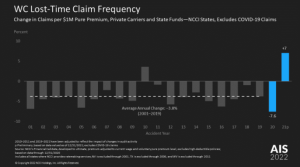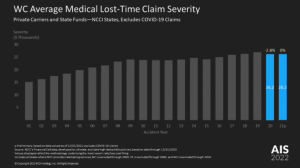More details from NCCI Chief Actuary Donna Glenn’s presentation yesterday…
Claim costs are driven by employment, frequency (what percentage of workers gets hurt), the cost to provide medical care to those injured workers and the cost of paying their income benefits while off work.
While claim frequency bumped up in 2021, the increase just offset an almost-identical decrease in 2020. When you pull out the COVID stuff, the average annual decline in work comp claim frequency has been 3.8% over the last 20 + years.

This means – in three years there will be 11.4% fewer claims than there are today – that’s one out of ten claims.
Indemnity “severity” didn’t change last year compared to 2020, leveling off after a pretty consistent increase from 2016 to 2020.
Medical “severity” for loss time claims didn’t increase from 2020 from 2021 – it was dead flat – and has been pretty much flat since 2016.

Ed. note – while widely used in the work comp industry, the use of “severity” to describe what is nothing more than “cost” isn’t helpful. Medical severity should be a clinical measure, not a financial one. I would argue that the use of “severity” further distances the industry from increasing its understanding of the role of medical care in workers’ comp.
Glenn attributed the lack of movement in part to a shift to delivering care in outpatient facilities…more details to come in the final presentation today.
What does this mean for you?
Work comp medical costs are NOT increasing – my guess is the major progress most payers have made in reducing drug costs- and more specifically opioid over-use – has been a major help.



Good point Joe regarding severity. We confuse medical pay ie new diagnostic tool, new treatments with injuries that are truly impacting an employee’s ability to return to pre injury functionality . In the early days of comp those type injuries were counted as sever but improved working conditions and focus on safety has greatly reduced those type of injuries. Severity today is not the severity of our grandfathers and grand mothers. .
Well said Todd – Work Comp must do a much better job understanding medical drivers.
The workers; comp industry often hides is virtues under a barrel. As Joe says, claims frequency is on a long term decline, mirrored by OSHA data. This is less due to workforce shifts to safer occupations and. more to board improvement in management practices. The people who know this, and should be given more recognition, are corporate risk managers. What is a managed caren vendor or claims vendor to do? — pivot into solving challenges in non- occupational conditions.
Peter – my guess is stakeholders – of which I am one – don’t want to publicize the reality that work comp is shrinking – as this makes it less attractive to new hires, current staff, insurers, investors and the like.
That’s unfortunate as work comp could still improve by leaps and bounds.
be well Joe